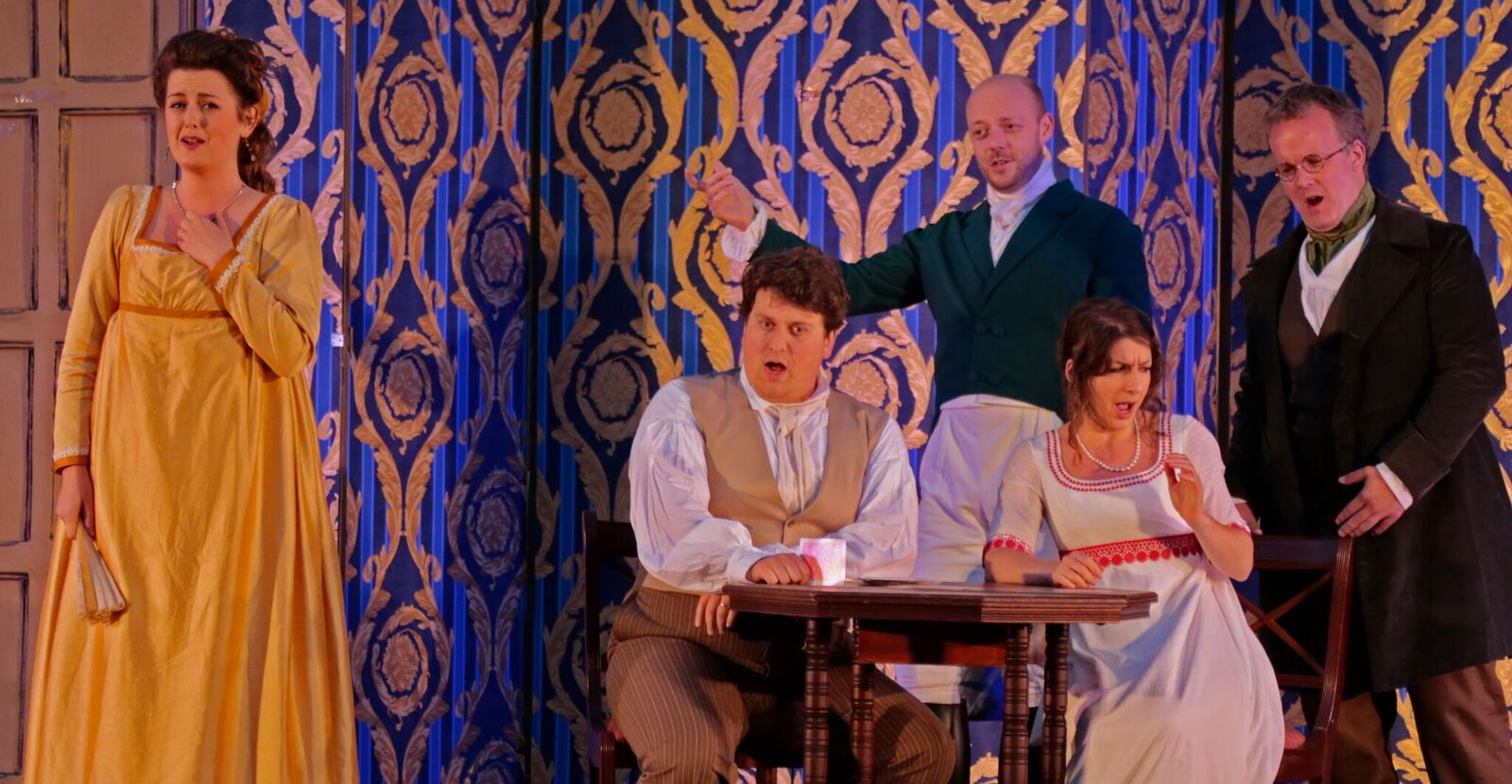The Full Monteverdi and More
[dropcap]T[/dropcap]he 450th anniversary of Claudio Monteverdi’s birth has seen a blossoming in performances of his music, and the Edinburgh International Festival played its part by hosting a number of Monteverdi 450 events, clustered round a major presentation of his three surviving operas directed by Sir John Eliot Gardiner. The cycle, semi-staged in Edinburgh’s magnificent Usher Hall, opened with Orfeo, Monteverdi’s earliest surviving foray into the genre and one of the earliest of all full operas.
One of the chief advantages of this mode of presentation is that the full orchestra is onstage with the singers, allowing the subtleties and full-colour range of the various period instruments to permeate the texture. In the case of Orfeo, these include a full string section, a generous complement of cornetti and sackbuts, recorders, dulcian and a plethora of continuo instruments including Baroque guitars, chitarroni, harpsichords, organs, harp and viol. The full richness of Monteverdi’s carefully nuanced sound-world was allowed to develop before our eyes as well as our ears, while the instrumentalists were also able fully to interact with the singers.
The various soloists and chorus singers used the whole stage area including the organ loft at the back to dramatise the powerful story of the demi-god musician Orpheus and his doomed quest to retrieve his wife Euridice from Hades. The demanding part of Orfeo was taken by a silky-voiced Krystian Adam, whose beautifully expressive tenor voice, deft vocal ornamentation and convincing dramatic presence made him the perfect protagonist. His account of the famous show aria “Possente spirto”, a vehicle for the vocal virtuosity of the creator of the role, Francesco Rasi, was mesmerising. Also both vocally and dramatically impressive was Gianluca Buratto, whose characterisation of Caronte the boatman of the underworld was utterly convincing. The proceedings had opened with the fresh voice of Hana Blažiková in the role of Musica, who in addition to engaging the audience in the story accompanied herself at one point on the harp, an instrument which Orfeo surprisingly made no recourse to in spite of the references to a lyre in his recitatives. Ms Blažiková also proved a haunting Euridice, while the brief role of the Messaggera who imparts the tragic news of Euridice’s demise, was lent wonderful gravitas by the superb voice of Lucile Richardot, who would be an unforgettable Penelope the following night in Il Ritorno d’Ulisse in Patria.
Impressive as all the guest soloists were, also dovetailing perfectly with the chorus when necessary, it was the ensemble singing and solo contributions of The Monteverdi Choir, which constituted the highlight for me of this remarkable performance. They are to my mind simply one of the finest vocal ensembles in the world, and showed their astonishing versatility by morphing into a dream opera chorus with pinpoint vocal precision and their customary gleaming tone. Under the inspired direction of Eliot Gardiner, one of the leading exponents of Monteverdi’s music, this minimalist performance on which he had collaborated with Elsa Rooke, Isabella Gardiner and Rick Fisher, had an iconically definitive quality.
It is a mark of the depth of talent in his vocal and instrumental forces that a quick reshuffle of personnel allowed Sir John to stage Il Ritorno d’Ulisse in Patria the following evening. Hana Blažiková stepped easily into the virtuoso role of Minerva, raining blizzards of vocal ornaments, while Furia Zanasi, whose moving duet with Orfeo as Apollo the previous evening had been memorable, transferred capably to the title role of Ulisse. His wife Penelope, was as I mentioned, sung by Lucile Richardot, to me the vocal discovery of the project and whose wonderfully strong lower register lent her portrayal of the beleaguered queen an overwhelming pathos. Her clamouring suitors were splendidly characterised as were the various interfering gods and goddesses, while the previous night’s Orfeo, Krystian Adam, made for a lively and convincing Telemaco. It would also be unfair not to mention the individual tour de force by Robert Burt as the comically gormandising Iso. Again the minimalist staging proved ideal, while the idea of Penelope herself forming the shape of the bow which must be bent by the suitors and which is eventually mastered only by Ulysses, was nothing short of brilliant. Perhaps more obscure was the recorder player Rachel Becket abandoning her crotchets for crochet, spending her bars rest weaving and unweaving a woollen web, clearly an allusion to Penelope’s famous stratagem to stall the suitors. Perhaps not many audience members even noticed the recorder player’s industry, and most would have dismissed it as a rather cheeky distraction.
In our lives, only 24 hours had elapsed since Orfeo, but in Monteverdi’s life some thirty years had passed and he was now an old man. His orchestra had become much more of a conventional Baroque orchestra, and he was able to draw on a lifetime of compositional experience to animate the story of Ulysses’ return. This powerful masterpiece of his maturity includes some of his most impassioned writing, and the concluding duet between the eventually reconciled Ulysses and Penelope is both musically prescient and in this performance incomparably moving.
This veritable Monteverdi ‘Ring Cycle’ came to conclusion with the enigmatic L’Incoronazione di Poppea, an opera dating from the last year of the composer’s life. It is a work with a very modern feel to it – not one of the characters is likeable, evil triumphs over justice and ultimately we are asked to join in the celebrations for the coronation by a monstrous Roman emperor of his conniving mistress. I suspect the earliest Venetian audiences would have shared few of our qualms, and would probably easily have identified with the amoral universe presided over by a cynical pantheon of selfish and high-handed gods. In fact, this opera is thrillingly immediate in its amorality, and attention moves from the trivial complications of human relationships to the more sweeping themes of power and desire.
The only remotely sympathetic character, the philosopher Seneca, leant huge dignity and gravitas by Gianlucca Buratto (our Caronte in Orfeo) was disposed of before the mid-point of the opera, the chorus of his imploring friends providing one of the emotional high-points of the first part. The wronged Ottavia, was characterised strongly by Marianna Pizzolato, who cleverly showed the flaws as well as the virtues of Nero’s rejected first wife. Like Ottone, her one-time lover, and his new mistress Drusilla, she survives to be sent into exile. You will note that Monteverdi’s last opera prepares the way for myriad Baroque operas in which the plot complications verge on the impenetrable! As all the characters seem equally despicable, attention moves to the way they express themselves musically, and in this respect Carlo Vistoli’s Ottone, Anna Dennis’s Drusilla and Lucille Richardot’s hilarious nurse Arnalta, counterpointed by Michal Cierniawski’s cross-dressed Nutrice were all memorable.
In the two lead roles, Hana Blažiková, (previously our Musica and Euridice) was superb as the ambitious scheming Poppea, but the voice of the evening for me was the remarkable male soprano voice of Kangmin Justin Kim. Originally a castrato role, the part of Nerone is normally these days sung by a woman, but recent developments in the world of falsetto singing have brought a few male singers into the soprano tessitura. Mr Kim is one such, and the astonishing effect of his penetrating, perfectly pitched and impassioned voice, particular when duetting in the same range with Poppea and wreathed in the tones of cornetti was simply stunning. As with all of the principals, Kim threw himself into his role with enormous energy and commitment, and we were privileged to be given a genuine glimpse of the stellar popularity of the great Baroque virtuoso castrati.
L’Incoronazione may probably be deemed the least effective of the three surviving Monteverdi operas, slow to start and prolix in plot, but in this production with this remarkable cast and instrumental forces it rose to a breath-taking climax, which proved a fittingly magnificent climax to a glorious week of Monteverdi. Opera is of course just one facet of the multi-talented Monteverdi, and as part of the Queen’s Hall concert series of the EIF Robert Hollingworth’s early music ensemble I Fagiolini joined forces with the English Cornett and Sackbut Ensemble for a performance of the master’s Vespers music. The 1610 Vespers has become something of a cult classic – ironically since many musicologists would point out that it probably ought not even to be regarded as a unified performance piece – but imaginatively Hollingworth has compiled an ‘alternative’ Vespers drawn mainly from Monteverdi’s 1641 publication Selva Morale e spirituale. In a much tauter, more modern style than the 1610 music, these psalm settings showcase the virtuosity of solo and duetting voices against a backdrop of a pair of virtuoso violins, brass ensemble and continuo. The Monteverdi pieces are interspersed with music by his contemporaries Ludovico Grossi da Viadana, Frescobaldi, Ignazio Donati, and by masters of the previous generation Palestrina and Giovanni Gabrieli.
The charming Monteverdi settings, including the lovely Beatus vir, were beautifully performed, with subtle ornaments, heightened drama and exquisite focus and intonation. Particularly ear-catching were the group’s high tenors Hugo and Benedict Hymas, whose full-voiced accounts of alto lines were stunning. Hollingworth acknowledges his debt to the pioneering work of Andrew Parrott and his Taverner Consort, and this performance was fully the equal of Parrott’s groundbreaking 1980s recording of this material, but taking account of recent musicological developments. There is always a danger when you interleave the music of your chosen composer with the work of unfamiliar masters that it might outshine it, and this was certainly a possibility in the case of Donati’s ravishing setting of Dulcis amor Jesu, while for me the magnificence of Gabrieli’s 14-part Magnificat stole the show. Less effective was the account of Palestrina’s Ave verum corpus, with the top line in a highly ornamented version by Giovanni Bovicelli. This was played on a rather wheezy mute cornetto along with male voices, but as Bovicelli was a singer and presumably wrote his passagi as a vehicle for himself, it would have been lovely to have heard this sung. That a singer with the necessary skills was available was clearly demonstrated when tenor Matthew Long gave a barnstorming performance of Monteverdi’s Salve O Regina – cascades of vocal ornaments recalled the operatic fireworks we had enjoyed earlier in the week – bringing this hugely impressive concert to an unforgettable conclusion.
What does a reviewer, sated with a veritable banquet of Monteverdi, seek out to cleanse his musical palate? The Chiaroscuro Quartet seemed the ideal solution, and when their Queen’s Hall recital opened with wonderfully rarified accounts of three of the Contrapuncti from Bach’s Art of Fugue my Monteverdi detox was already underway. If ever the virtues of using period instruments were in doubt, the group’s account of Haydn’s sixth opus 76 quartet provided decisive evidence. The lightness of touch stemming from the use of gut strings and period bows, meant that most of the issues, which can bog down performances of this work, simply didn’t arise. The young musicians, already eminent soloists in their own right, simply flew through the piece in a perfectly poised flurry of brilliance. Their technical assurance allowed the audience to focus on Haydn’s compositional inventiveness and wit – at several points, titters actually rippled round the hall – and their entertaining reading elicited ecstatic applause.
We came back to a different world for the second half of the concert, which featured Schubert’s disturbing Death and the Maiden Quartet. This time the period instruments lent a raw power to Schubert’s explosive music, and – playing with an almost unbearable intensity – the four musicians brought out the full drama of this unsettling work. The brief passages in the major key seemed oddly and disturbingly shallow, while the darker episodes seemed all the darker for the shadowy ambience of the gut strings. At the end of this impressive performance, I was left considering the many ways in which period instrument and authentic vocal performances have not just consolidated the work of the 1980s and 90s but have brought the presentation of early music to new heights of excellence, and at the same time to a wider audience.





